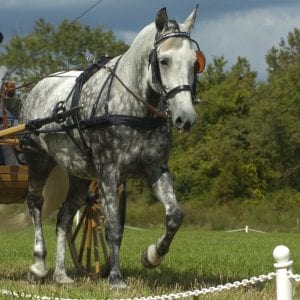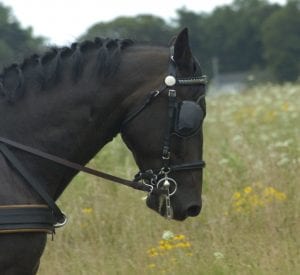
If it’s ring work or dressage that you are going to work on, what skills will you be working on? You could work on figures, rhythm, lengthening, or any number of other specific skill sets. If you’re planning to work on driving cones, how are you going to improve your skills with cones? Driving from one set of cones to another randomly doesn’t build skills as effectively as focusing on specific exercises and courses. If you’re headed out for a fitness drive, how are you going to accomplish getting your horse fit? Trotting kilometer after kilometer may be helpful to your horse’s fitness, but the benefits can be somewhat limited. Building in some transitions and interval trot, walk, and canter sets can create a more robust workout to build fitness.
It may seem obvious to say that in order to get specific results, you must have specific goals. What’s not as obvious, is how specific those goals can and perhaps should be. The more specific you are with your intention, the more obvious it will be if you met that intention, or missed it. If you do miss, you can be clear about how much you missed it, in direction or pace.
For example: It’s one thing to decide that you are going to make a transition to a walk or a halt. It’s another to choose a specific point at which the transition will be complete. With a specific point in mind, you can evaluate if the transition occurred early, right on the mark, or late. If you return to the same point or choose a similar point to execute your next transition, you can take what you learned from your first transition and adjust your timing accordingly.
RPTR
The reason trainers love working in rings is that they can repeat the same movement, in the same place, over and over again. In each repetition, there is the opportunity to adjust according to the last experience. The Repetitiveness creates Predictability. If you can predict that a horse is going to react in a certain way at a given point, you can act upon that prediction before it occurs. In other words, you can Train according to the prediction. If you acted correctly on the prediction with correct training, that training will be Repeatable.
If something is Repetitive, it’s Predictable, if it’s predictable, it’s Trainable, if it’s trainable it’s Repeatable.
Putting It Into Practice
When you’ve set aside some time to work your horse, decide what you are going to work on before you even start tacking him up! Choose the type of work you are going to do with your horse. Then choose what skill-set you want to focus on in that work mode. Next, decide what the exercises are that will help you focus on those skills. Perhaps you may choose a work mode of “dressage”, and further focus that plan on “Getting Straight” with the goal of “executing better centerlines.” Now, this is starting to look like a plan!
Making Specific Goals Specific-er
Students often tell me that they’ve driven an accurate center line, after having driven up the center of the ring. Their standard for accuracy is that their carriage was straddling the centerline. Of course, a carriage is close to a meter to a meter and a half wide. The horse can be off the centerline to the left, then wander across to the right, without taking the carriage off the centerline. Sure, the carriage traveled up the centerline, but the horse was “not straight on the centerline.” When I point this out to people, it’s not unusual that I get a little pushback: “Andy, you’re just splitting hairs now.”
The truth is that I am not asking for accuracy just for the arbitrary purpose of being able to put your horse on a specific mark (though that is a very useful skill.) I am asking for the increased accuracy to improve the student’s performance.
As you become more specific with your intentions, your communications with your horse become more specific. On top of that, your whole nervous system focuses on those results. That sets off a series of involuntary motions your body that supports reaching your goal or resist moving away from the intended result. The ancillary communications that don’t have much to do with your goal fall by the wayside.
Stick To The Plan!!
Probably the biggest obstacle you’ll encounter in sticking to your plan is your horse. They are very fickle beasts and aren’t always that interested in participating in the activity that we’ve decided to do with them.
To be quite honest, when I started developing lesson plans I was a bit skeptical that they would “work.” After all, just because I wanted to work on Developing The Walk that day, the horse I was working with may have had other ideas for what we should do all together. It was a challenge to remain focused on the lesson plan while the horse presented all sorts of alternatives. But when I stuck to the plan, it paid off. Before the end of the lesson plan, the horse and I were on the same page, working toward the same goals.
To have the greatest success with the plans you’ve made with your horse you have to stick to the plan. That means not getting caught up in anything that doesn’t have to do with the work you’ve decided to focus on. In the above example, we were talking about driving straight lines. With that plan in mind, you’d choose specific targets to drive over, and focus your intentions on your communication to drive to those targets as accurately as possible.
While working on that plan if your horse’s walk or trot isn’t everything you’d like it to be, don’t worry about it. That’s not what you are out there to work on. If your horse gets distracted by another horse or your dog, bring his focus back to the task at hand that you’ve decided to focus on. In fact, ignore anything that doesn’t have to do with the skill set that you are working on! It’s through this singular focus on specific skills that you can improve those skills until they become second-nature. Once that happens you can apply those skills without thought while working on another skill set.
This all takes barrels full of patience, persistence, and hard work. Of course, that doesn’t mean that working your horse always has to be “work.” There’s always a time and place for going out on a recreational drive and taking your horse wherever whim and whimsey suggest. Be sure to keep those drives on the agenda, because after all, it’s all about having fun with your horse. Of course, with the improved skills you’ll get from those focused workouts, your fun drives will probably be even more fun!


